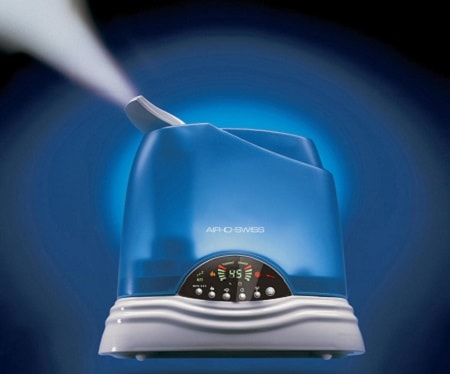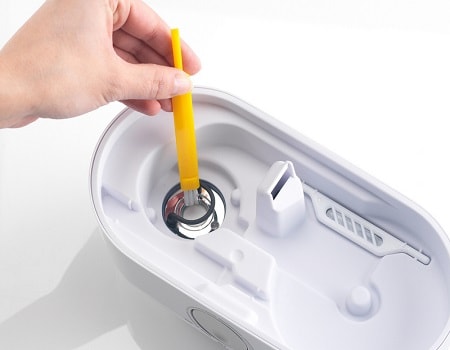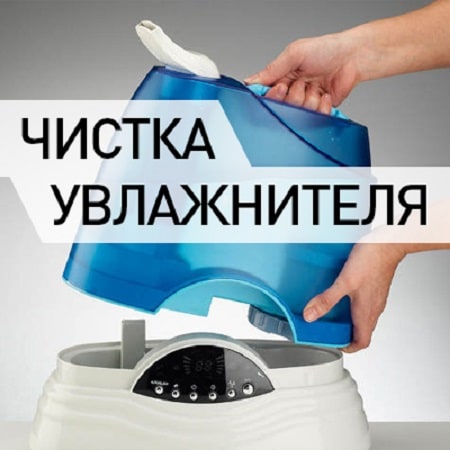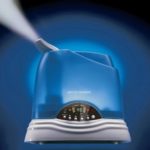Probably, it is no secret to anyone that the water in our taps is so hard that all household appliances are covered with a deposit that prevents their normal functioning. In this article, we will talk about how to clean a humidifier.
How quickly does plaque build up on a humidifier?

Plaque forms as quickly as hard water is poured into it. And, literally, after ten days, his insides are covered with scale.
Of course, there is a cardinal method of solving this problem, namely, simply refusing water from the tap. Pouring purified or distilled water, there will be no plaque, but ... It's expensive! In just one night, an air humidifier consumes up to five liters of water. Now, count it yourself: we multiply thirty days by the cost of a ten-liter bottle of water, since that’s how much you need to pour into it per day.
If the price did not bother you at all, then you are clearly an underground millionaire. But for ordinary people with a very average income, such spending is completely useless. And it is better for them to clean the humidifier every one and a half weeks than to constantly make cash registers for the water merchants.
![]() See also - How to choose the best dehumidifier for your home
See also - How to choose the best dehumidifier for your home
What are the consequences of a dirty moisturizer?

The humidifier, like any other device, does not tolerate foreign formations on its body. Heavy metal salts adhere tightly and, if you do not clean it in time, then it will be problematic to scrape off this crust.
And the thicker the crust, the more electricity the device consumes. But, in addition, the quality of humid air will be much worse!
In addition, if the humidifier is not cleaned, bacteria, mold and fungus settle in it. But this is a serious problem. A fungus trapped in the lungs can create big health problems for the owner of the device, instead of strengthening his health by generating an ideal microclimate.
Fungal pneumonia of the lungs is a serious illness. And it develops exclusively due to the fact that a person inhaled air saturated with fungal spores.
Such an infection simply knocks down people with weak immunity, the elderly, children or those with asthma. In general, just the target audience, which most often acquires air humidifiers, in order to strengthen their weak breathing apparatus.
And most importantly, it is much more difficult to cure such a disease than the usual viral pneumonia. Therefore - do not be lazy and do not joke with it! Timely cleaning of the humidifier is not a simple whim, but a necessity.
![]() See also - Making a humidifier with your own hands
See also - Making a humidifier with your own hands
Types of humidifiers and specific contamination of each of them
As we wrote in the previous article, there are three types of moisturizers:
- Cold
- Steam
- Ultrasonic
Most of all, steam humidifiers are susceptible to the formation of deposits of heavy metal salts, due to the fact that the water in them constantly boils. But, the formation of mold and mildew there is almost impossible.
Although, if you don't use it and leave it disconnected for a couple of weeks, but filled with water, then mold will start there too.
So, steam rooms are more susceptible to salt deposits, and cold and ultrasonic ones are more susceptible to mold and mildew. And, accordingly, scale must be fought with some methods, and with fungus - with others.
How to remove plaque from a humidifier

Descaling your humidifier is easy if it is a steam humidifier. It is enough to put citric acid in a reservoir of water and put it on start-up, let it boil for half an hour. The only thing is that it will need to be taken out to the balcony, since breathing air with acids is a dubious pleasure. Yes, and it is harmful.
Other types of humidifiers do not boil, so cleaning will take longer. A citric acid solution is simply poured into their tanks and left for at least twelve hours. After that, rinse the humidifier very thoroughly with plain water.
In principle, if you clean these devices every 10 days, then a large layer of plaque will not form. And in such cases, you just need to wash with a toothbrush, with detergent, the reservoir and the attachment.
![]() See also - The benefits and harms of household air humidifiers
See also - The benefits and harms of household air humidifiers
How to remove fungus from a humidifier
If you have not used the device for a long time, but after opening the air humidifier, you find that the walls are covered with a layer of fungus, then you need to clean it immediately.
Rinsing with plain water will do nothing. You need to wash it thoroughly with hot water and detergent. Then, rinse with boiling water and then pour the lemon solution into it and rinse thoroughly at the end of the procedure.
After that, the fungus will definitely not have the slightest chance of reproduction!
![]() See also - How to choose the perfect air conditioner for your home and apartment
See also - How to choose the perfect air conditioner for your home and apartment
How to properly operate a humidifier
We will not tell you that you need to pour clean water into it, since it is expensive and unrealistic. But, we can advise you one thing: to clean the device every 10 days.
Also, if you are leaving somewhere, be sure to free the purifier from the remaining water and wipe it dry. In this case, it does not form ominous mold and does not need a thorough cleaning upon arrival.
Well, now you know how to clean a humidifier from scale and fungus, and now, your ideal microclimate in the house will not be disturbed by any bacteria!
See also:
- Top 10 Royal Clima humidifiers and air purifiers according to customer reviews
- 10 best AIC humidifiers and air purifiers
- Timberk's 10 Best Humidifiers of the year
- 10 best Boneco humidifiers
- 10 best air ionizers for your apartment


